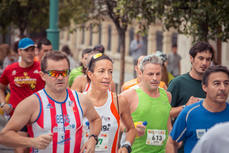 Acupuncture is a safe, effective method of treating pain and soreness from athletic endeavors. In my office I most frequently see things like plantar fasciitis and IT Band pain, but have also successfully treated shin splints and aided patients recovering from surgeries such as ACL reconstruction. Thermal imaging has shown acupuncture decreases inflammation, doppler ultrasound shows that it increases blood flow to needled areas, and neuroimaging studies show that it decreases brain activity involved in registering pain and increases brain activity involved in healing. I love treating sports injuries because patients are able to see results from the treatments so quickly and are able to stay active and pain-free. Studies have also found that acupuncture causes your muscles to release a substance called adenosine, which stimulates tissue repair and decreases inflammation. It also releases endorphins, which are your body’s natural pain relievers.
Acupuncture is a safe, effective method of treating pain and soreness from athletic endeavors. In my office I most frequently see things like plantar fasciitis and IT Band pain, but have also successfully treated shin splints and aided patients recovering from surgeries such as ACL reconstruction. Thermal imaging has shown acupuncture decreases inflammation, doppler ultrasound shows that it increases blood flow to needled areas, and neuroimaging studies show that it decreases brain activity involved in registering pain and increases brain activity involved in healing. I love treating sports injuries because patients are able to see results from the treatments so quickly and are able to stay active and pain-free. Studies have also found that acupuncture causes your muscles to release a substance called adenosine, which stimulates tissue repair and decreases inflammation. It also releases endorphins, which are your body’s natural pain relievers.
Traditional Chinese Medicine (TCM) views pain of all types as stagnation of blood and qi in your body. However, depending on your circumstances, there can be other things involved such as excess cold, heat, depletion of overall energy or even stress exacerbating pain. This explains why two patients with tennis elbow may receive different acupuncture treatments.
Another unique feature of TCM is that in almost all cases, applying ice to the injured area is not recommended. Chinese Medicine sees cold as having the potential to increase stagnation, much like cold weather slows the flow of a river and creates ice eventually. Applying ice to an injured area is a common practice but is actually not backed by any scientific studies to show it really helps (see this article with accompanying studies). There is growing evidence that it can actually delay healing. I generally recommend that patients first try heat, unless the area feels hot to the touch. In this case, cooling herbal liniments can help.
Chinese Medicine sees the body as a whole, stimulating both the injured area as well as distal points to increase circulation, improve energy and decrease stress in your body. The acupuncturist will perform palpation over your muscles, needling at tender spots (called Ashi points) as well as needling at special areas called motor points. A motor point is the most electrically active area of the muscle and often elicits a quick “jump” or a dull, achy feeling. A motor point is the muscle’s “reset” button, eliminating excess tension and stress.
In addition to injury treatment, acupuncture is great for prevention and keeping your joints and muscles in good working order. If you are training for a marathon, triathlon or simply have dealt with a lot of injuries in the past and want to avoid a repeat, targeted weekly to bi-weekly acupuncture sessions can help quite a lot. And in preparation for that big event, if you are worried about pre-race anxiety your acupuncturist can add in points specifically for calming the mind.
Commonly treated Conditions:
Sore muscles from overexerting one’s self
Plantar Fasciitis
Tennis Elbow
Shin Splints
Rotator Cuff Tendinitis
IT Band pain
Stubborn Hamstring pain or tightness
Recovery from surgery or major injury
Ankle Sprains
Knee Injuries
I always recommend getting an assessment by an orthopedic doctor if your injury is debilitating or intense pain persists for longer than 24 hours- I am a firm believer in the value of getting an accurate diagnosis and evaluating the need for surgery or physical therapy. If your doctor simply prescribes rest and pain relievers or anti-inflammatories, acupuncture can be a great alternative. In general, unless you have a broken bone, dislocation, extreme swelling and pain or your doctor recommends immediate surgery, acupuncture can help.
The other good news is that insurance plans are increasingly covering acupuncture sessions for pain therapy.
More Articles of Interest:
